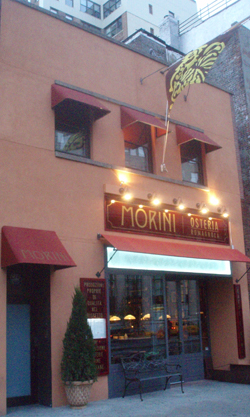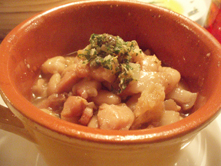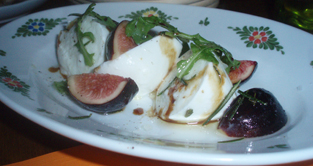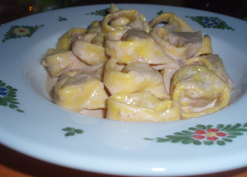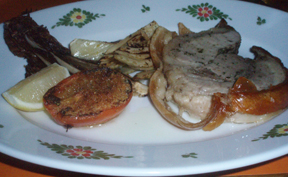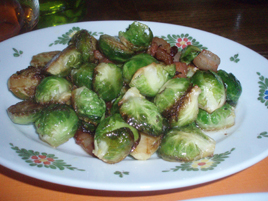’Tis the season when food writers sum up a year’s worth of dining, so here are my top ten new restaurants of 2010.
It was not a great year. No new restaurant earned three or four stars on our rating scale, although two came close: Millesime and Tamarind Tribeca. Sam Sifton of the Times awarded three stars to just one new place, Colicchio & Sons, but most critics (including me) found it disappointing. There is no “almost” in Timesspeak, but it did not appear that Sifton came even close to awarding three stars to any other new restaurant.
This does not mean that we ate badly, only that our best meals in new restaurants were at the lower end of the dining spectrum. This isn’t really surprising. Restaurants generally have six to eighteen-month planning cycles. If you’d been planning a new place in 2008 or 2009, how ambitious would you have been?
I’ve ordered the restaurants based on my dining experiences, which in most cases was one visit. Unlike the pro critics, I’m spending my own money. If I am disappointed, I’m not going to go back a second or third time, just to see if it was a fluke. Even when I like a place, I often don’t have the time or money to go back right away.
Some of the restaurants listed below actually opened in late 2009. I’ve included them if my first (or only) visit was in calendar year 2010.
 1. Millesime. Chef Laurent Manrique returns to NYC (he was here in the ’90s), having won two Michelin stars in San Francisco. This classic French seafood brasserie doesn’t soar quite as high as that, but it was the best meal we had this year in a new restaurant. In our book, the food was three stars, though the service had some catching up to do. P.S. The downstairs “salon” is pretty good, too.
1. Millesime. Chef Laurent Manrique returns to NYC (he was here in the ’90s), having won two Michelin stars in San Francisco. This classic French seafood brasserie doesn’t soar quite as high as that, but it was the best meal we had this year in a new restaurant. In our book, the food was three stars, though the service had some catching up to do. P.S. The downstairs “salon” is pretty good, too.
 2. The Breslin. We adore the Breslin. Chef April Bloomfield’s fat-forward menu won’t be to all tastes, and it could be downright artery-clogging if we ate like this every day, but the chef doesn’t pander, and everything she does is impeccably prepared. They have a great lamb burger, and it’s great for breakfast too.
2. The Breslin. We adore the Breslin. Chef April Bloomfield’s fat-forward menu won’t be to all tastes, and it could be downright artery-clogging if we ate like this every day, but the chef doesn’t pander, and everything she does is impeccably prepared. They have a great lamb burger, and it’s great for breakfast too.
 3. Tamarind Tribeca. This big-box Indian restaurant was the sleeper hit of 2010. We never imagined it would be this good. I gave it 2½ stars, but looking back, I am not sure why it didn’t get three. Of course, we sampled only a sliver of the menu, but what we had was flawless.
3. Tamarind Tribeca. This big-box Indian restaurant was the sleeper hit of 2010. We never imagined it would be this good. I gave it 2½ stars, but looking back, I am not sure why it didn’t get three. Of course, we sampled only a sliver of the menu, but what we had was flawless.
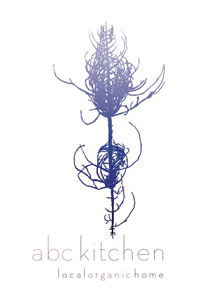 4. ABC Kitchen. Jean-Georges Vongerichten entered the farm-to-table game with a splash. Who’d have expected a restaurant in a home furnishings store to be this successful? JGV’s restaurants are notorious for quickly turning mediocre, after the attention-deficit chef wanders off to his next project. But if Chef Dan Kluger sticks around, ABC Kitchen could stay relevant for a long time. But good luck getting a last-minute reservation: the place is perpetually packed.
4. ABC Kitchen. Jean-Georges Vongerichten entered the farm-to-table game with a splash. Who’d have expected a restaurant in a home furnishings store to be this successful? JGV’s restaurants are notorious for quickly turning mediocre, after the attention-deficit chef wanders off to his next project. But if Chef Dan Kluger sticks around, ABC Kitchen could stay relevant for a long time. But good luck getting a last-minute reservation: the place is perpetually packed.
 5. Ciano. Chef Shea Gallante (ex-Cru) returns to New York with a wonderful (if expensive) Italian restaurant, with a terrific wine list that allows most bottles to be ordered by the half. We would have rated this one higher, but one of our entrées was a dud (over-priced, under-cooked lamb chops).
5. Ciano. Chef Shea Gallante (ex-Cru) returns to New York with a wonderful (if expensive) Italian restaurant, with a terrific wine list that allows most bottles to be ordered by the half. We would have rated this one higher, but one of our entrées was a dud (over-priced, under-cooked lamb chops).
 6. Kin Shop. The year’s best Thai restaurant comes from an American, Top Chef alumnus Harold Dieterle. Not quite authentic, but clearly inspired by Thailand, the menu has both hits and misses, but the former are very good indeed.
6. Kin Shop. The year’s best Thai restaurant comes from an American, Top Chef alumnus Harold Dieterle. Not quite authentic, but clearly inspired by Thailand, the menu has both hits and misses, but the former are very good indeed.
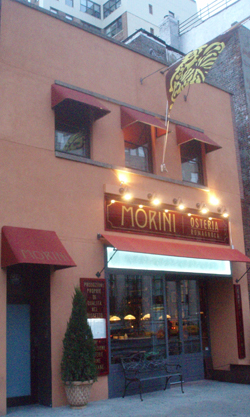 7. Osteria Morini. Chef Michael White’s first casual Italian restaurant is dedicated to the hearty cuisine of Emilia-Romagna. Some of the dishes may seem over-bearing and unsubtle, but we liked just about everything we tried, even if the soundtrack is too loud and the paper napkins too cheap for the prices White is charging.
7. Osteria Morini. Chef Michael White’s first casual Italian restaurant is dedicated to the hearty cuisine of Emilia-Romagna. Some of the dishes may seem over-bearing and unsubtle, but we liked just about everything we tried, even if the soundtrack is too loud and the paper napkins too cheap for the prices White is charging.
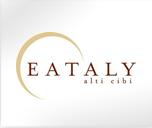 8. Manzo. If we were judging the food alone, we’d rate Mario Batali’s temple of Italian beef higher, but it’s smack dab in the middle of the city’s most crowded supermarket, Eataly. It is awfully expensive, for a space that is so unpleasant.
8. Manzo. If we were judging the food alone, we’d rate Mario Batali’s temple of Italian beef higher, but it’s smack dab in the middle of the city’s most crowded supermarket, Eataly. It is awfully expensive, for a space that is so unpleasant.
 9. Riverpark. This is a “Tom Colicchio restaurant” that doesn’t charge Tom Colicchio prices. His former sandwich guy, Sisha Ortuzar, turns out to be a fine chef. But how many people will become regulars at a place that’s half-a-mile from the nearest subway station? We sure won’t.
9. Riverpark. This is a “Tom Colicchio restaurant” that doesn’t charge Tom Colicchio prices. His former sandwich guy, Sisha Ortuzar, turns out to be a fine chef. But how many people will become regulars at a place that’s half-a-mile from the nearest subway station? We sure won’t.
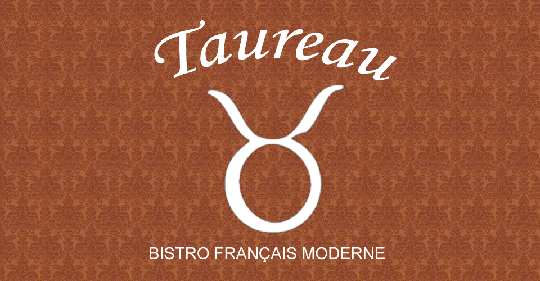 10. Taureau. Chef Didier Pawlicki (of La Sirène) opened this all-fondue joint to very little critical notice. We loved our meal, but we’re not going to return regularly for such a limited menu. Still, we think it’s a great date place. There’s nothing like cooking raw meat in a shared pot of boiling oil to bring people closer.
10. Taureau. Chef Didier Pawlicki (of La Sirène) opened this all-fondue joint to very little critical notice. We loved our meal, but we’re not going to return regularly for such a limited menu. Still, we think it’s a great date place. There’s nothing like cooking raw meat in a shared pot of boiling oil to bring people closer.
*
Honorable Mentions: There are a few notable places that didn’t make our list, that nevertheless deserve a word or two.
 1. Anfora. This quickly became my go-to wine bar after it opened in May. I probably visited fifteen or twenty times. But unlike some wine bars, the food menu here is too limited to qualify Anfora as a real restaurant. That’s why it didn’t make my top ten.
1. Anfora. This quickly became my go-to wine bar after it opened in May. I probably visited fifteen or twenty times. But unlike some wine bars, the food menu here is too limited to qualify Anfora as a real restaurant. That’s why it didn’t make my top ten.
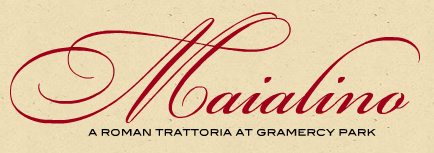 2. Maialino. Danny Meyer’s Roman Trattoria actually opened in late 2009, and we reviewed it in December, but most of the pro critics reviewed it this year, so you’ll probably see it on a lot of Top Ten lists. Our own meal there was slightly disappointing, but it was probably atypical, as Meyer’s restaurants tend to get better over time.
2. Maialino. Danny Meyer’s Roman Trattoria actually opened in late 2009, and we reviewed it in December, but most of the pro critics reviewed it this year, so you’ll probably see it on a lot of Top Ten lists. Our own meal there was slightly disappointing, but it was probably atypical, as Meyer’s restaurants tend to get better over time.
 3. Má Pêche. You’ll definitely see David Chang’s first midtown restaurant on most critics’ top-ten lists, despite the fact that hardly anyone thought he had improved upon, or even equaled, what he’d achieved in the East Village. But in a bad year, Chang’s seconds are still pretty good. I dined here three times, and will again, but the review meal was not that great, although I hear the menu has changed a lot since then.
3. Má Pêche. You’ll definitely see David Chang’s first midtown restaurant on most critics’ top-ten lists, despite the fact that hardly anyone thought he had improved upon, or even equaled, what he’d achieved in the East Village. But in a bad year, Chang’s seconds are still pretty good. I dined here three times, and will again, but the review meal was not that great, although I hear the menu has changed a lot since then.
 4. Recette. Jesse Schenker’s small-plates restaurant will also be on a lot of top-ten lists. I liked everything I tried; by the same token, I can’t actually remember any of it without re-reading my own review. It lacked (for me) any of the more memorable dishes from our top-ten list.
4. Recette. Jesse Schenker’s small-plates restaurant will also be on a lot of top-ten lists. I liked everything I tried; by the same token, I can’t actually remember any of it without re-reading my own review. It lacked (for me) any of the more memorable dishes from our top-ten list.
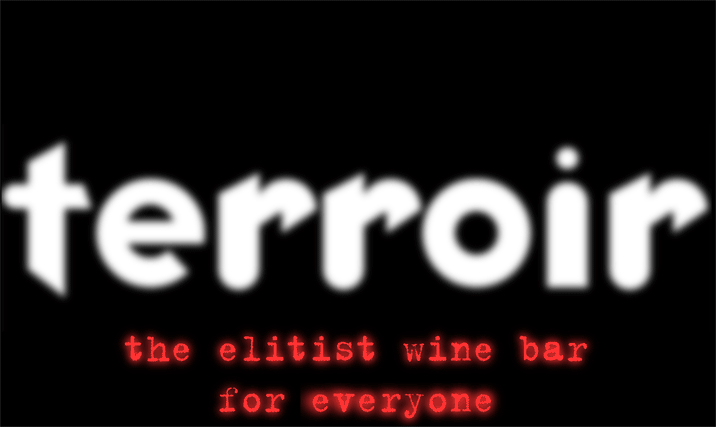 5. Terroir Tribeca. This was my other go-to wine bar, and unlike Anfora, it does have enough of a menu to qualify as a real restaurant. It doesn’t make the top ten because it’s practically the same as Terroir in the East Village, which opened in 2008. (Tamarind Tribeca, which does make our top ten, is quite a bit different from the original Tamarind in the Flatiron District.)
5. Terroir Tribeca. This was my other go-to wine bar, and unlike Anfora, it does have enough of a menu to qualify as a real restaurant. It doesn’t make the top ten because it’s practically the same as Terroir in the East Village, which opened in 2008. (Tamarind Tribeca, which does make our top ten, is quite a bit different from the original Tamarind in the Flatiron District.)
 Tuesday, April 8, 2014 at 08:44PM
Tuesday, April 8, 2014 at 08:44PM 
 How much Michael White is too much Michael White? At Ristorante Morini, his seventh New York restaurant in as many years, the chef is betting that we still don’t have enough.
How much Michael White is too much Michael White? At Ristorante Morini, his seventh New York restaurant in as many years, the chef is betting that we still don’t have enough. White may be repeating himself, but have you tried to book a table at Marea lately? After five years in business, it is still solidly booked at prime times. Opening Ai Fiori, a second restaurant in the same mold, did nothing to tamp down demand, so why not build a third?
White may be repeating himself, but have you tried to book a table at Marea lately? After five years in business, it is still solidly booked at prime times. Opening Ai Fiori, a second restaurant in the same mold, did nothing to tamp down demand, so why not build a third?
















